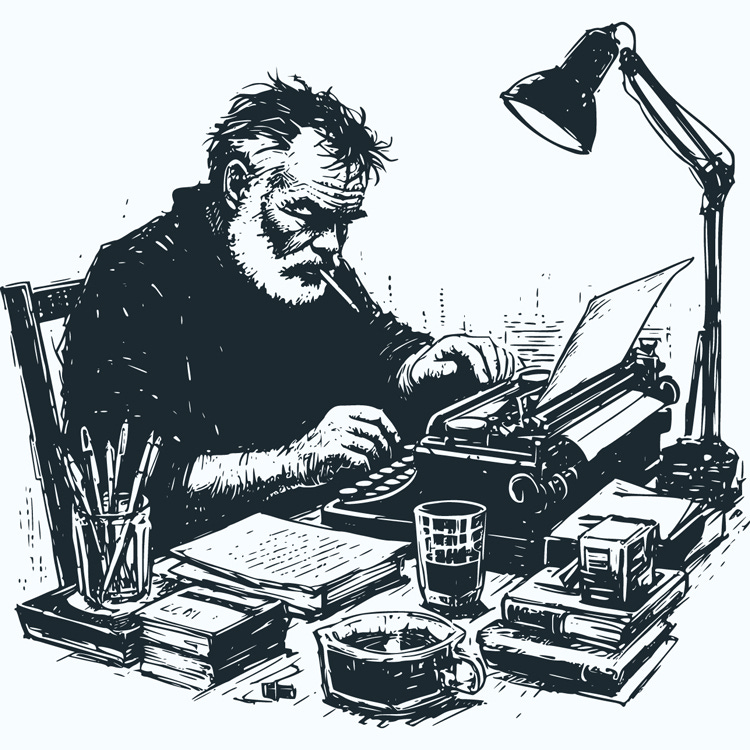✍️ What’s Your Story?
or, How to Find Your Story’s “Why”
Is it just me, or does the world seem to have more gurus these days?
I mean, they’ve always been around. But they used to be real gurus. Like the Beatles’ Maharishi Mahesh Yogi.
At some point, about the time of the Internet taking shape, gurus started to pop up everywhere – and not always in a religious context. Type in “marketing guru” and you get names like Seth Godin, Neil Patel, and Gary Vaynerchuk. (For the record, I’m not sure they call themselves gurus. But other people do.)
As a marketing writer, I get it. You need to make an immediate connection with the reader/listener/watcher, and “guru” is great shorthand for someone who’s worth listening too. One word. Four letters. Two rhyming syllables. It would be weird if people didn’t use it.
I have a theory that part of what makes the 21st-century guru is the ability to come up with a simple, singular idea that sticks. It’s so mystical and magical when a “guru” shows you the hidden obvious right before your eyes!
One leadership guru started with a very simple concept: Find Your Why. He’s reached cult status in certain circles with this idea. A friend introduced me to the concept about eight years ago, and I instantly connected with it. Find Your Why has helped me help new small businesses iron out their messaging and dig into what really they want to offer. It can help people differentiate their businesses from that of others.
But here’s why I’m talking about this today: Find Your Why, a concept invented by Simon Sinek, also helps in my fiction writing. I think it can help you too, whether you’re writing fiction, non-fiction, poetry, or bumper stickers. (Maybe especially bumper stickers…)
From the Ephemeral to the Concrete
Anyone who’s been in a job interview has heard some variant of this familiar question: Why do you want to work here?
I think this question is so effective because it cuts through the bullshit and gets to the heart of it. If they are already fans of the company, love the position they’re applying for, and can talk for hours about what they can do to fit in there, he or she is probably a person you want working for you.
It reminds me of an Ernest Hemingway quote that I used to puzzle over, but now I understand a bit better: Find your one true sentence. I mean, WT actual F? One true sentence. Pfft. Another great example of Papa being reductive to the point of incomprensibility.
Today, I happen to think that “Find Your Why” and finding your “one true sentence” are one and the same. It’s that… ephemeral idea that’s at the heart of what you are trying to write, and in doing so, make the idea concrete. Like that job interview, it also cuts through the bullshit. What’s the story all about? Where are you taking me, the reader?
Why does it matter if I read this or not!?!
In Save the Cat Writes a Novel, which I’ve talked about before, the second beat is “Theme Stated”. This is usually an off-hand remark, often made by someone other than the main character, that encapsulates the whole meaning of the story in one line. It’s the thing that the main character needs to learn. For example,
In The Great Gatsby, I would argue that Tom’s interjection that “Civilization’s going to pieces” is the Theme Stated (though cleverly on the part of Fitzgerald, it’s not in the way Tom thinks).
In When Harry Met Sally, the Theme Stated comes from Harry, who says something along the lines of, “Men and women can’t be friends, because the sex thing always gets in the way.”
Notice that the first one is somewhat ephemeral in itself while the second is upfront with no room for misinterpretation. I think a lot of that has to do with the medium (novel vs. movie) and the purpose (literary vs. rom-com). Regardless, you can see how the writers took each idea and built their respective works around them. Nora Ephron, who wrote When Harry Met Sally, said explicitly that the question she and director Rob Reiner established from the beginning was whether or not men and women could be friends. I’m not so sure Fitzgerald could draw such a straight line, but I know that at least in general terms, he had a clear idea of what direction he was taking.
I can tell you that from personal experience, part of what left me stuck in my own WIP was lack of clear direction. Save the Cat! helped me realize that I needed a theme statement in the first place. Once I was able to get a clearer idea of my Theme Stated – once I was able to Find My Why – other decisions such as what type of person my main character was and how the secondary characters would affect his journey became easier.
How to Find Your Why
I’ve gathered a few ideas here on how to find your why. This technique is primarily for fiction, but as a non-fiction writer in my day job, I know that finding the why of the story helps, too. Depending on the type of poetry you write, it might help you there, too.
What truth do you want to shout from the rooftops? This comes directly from Abbie Emmons, who I’ve mentioned in these pages a few times. She suggests noodling on this question and brainstorming ideas on a piece of paper. Your ideas don’t have to flow in a coherent paragraph – the words don’t even have to make sense. Just put down what you feel are ideas close to or related to your story’s “why”. Follow the threads deeper and deeper until you find your one true sentence.
Hash it out with a friend or other writer. This would be a tough one for me, because I basically get hives talking about my WIP before it’s done. (I hear some tittering out there…) But if you don’t have any such allergies, hashing out the story with a friend – especially a writer friend who gets it – can help you find your why. It’s much like talking to someone about any problem in your life: they can be a sounding board and give you new viewpoints to look at things while you “try ideas on”.
Write your book jacket blurb. I used this one myself lately, and that exercise was one of the inspirations for this post. To hook the reader, you need to quickly tell them WHAT the story is, WHO the main character, and WHY the story matters. When I wrote mine, it forced me to fill in some blanks on the fly, making me look at the story a whole new way. I was very happy with the results! If you need some help on the nuts and bolts of the book jacket blurb, Masterclass has a decent outline here.
Write an article or a letter to a friend. I’ve found that writing “story” doesn’t come naturally to me as it used to for some reason. On the other hand, decades of day-job writing means I can write a non-fiction article relatively easily. So why not pretend my fiction story already did happen? Writing an article or a letter to a friend helps you explain the story to that person – and in turn yourself. A neat little trick to pull on the ol’ brain! Note: you don’t send this letter to your friend; just keep it for yourself.
Write a postcard to a friend. Similar to the above, but you get to tell your friend why you love the story, not just what it’s about. I think of the postcard Julia Roberts wrote for that tourist in Eat Pray Love, talking about the scene around her and how it made her feel. This helps you flesh out the tone, style, and atmosphere of your story.
Write a poem about the story. I’ve used this one recently, too. I wrote short poems of certain scenes to help me understand them better on an emotional level. (See, How to Start EFFing Writing.) As it turned out, it also suggested new story ideas and new motivations for the characters in those scenes. I can’t tell you how happy I am with the results!
Key Takeaways: Whether you’re writing fiction or non-fiction, and sometimes when you’re writing poetry, finding your “why” helps you centre your story and point the way forward. This is particularly helpful when you’re stuck. However, whether you’re a plotter or a pantser, having a North Star to aim for is crucial for getting your story down.
Over to You – How Do You Flesh Out Your Stories?
Do you ever get stuck, not quite sure where your story is going? How do you get unstuck? Let us know in the comments below! I’m always looking for new ideas, especially as I’m trying to wrestle this latest WIP down!
I’ll leave you with Abbie Emmons full video on finding your story’s main theme. Scroll down below to view.
Until next time... keep writing with wild abandon!
~Graham
email me if you get lost.







Stellar post. Thanks for the repeated reminder to read Save the Cat, which remains unopened on my bedtable. I have a goal to START EFFING WRITING my next novel this month. This month that has officially arrived and is no longer on the horizon. I'm off to find my WHY now. 🥂
Excellent advice, Graham, as usual. Thought-provoking.